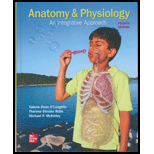
Which of the following is the correct circulatory sequence for blood to pass through part of the heart?
- a. right atrium → left AV valve → right ventricle → pulmonary semilunar valve
- b. right atrium → right AV valve → right ventricle → pulmonary semilunar valve
- c. left atrium → right AV valve → left ventricle → aortic semilunar valve
- d. left atrium → left AV valve → left ventricle → pulmonary semilunar valve
Introduction:
Homeostasis is maintained by continuous circulation of the blood in the body. Heart and blood vessels combine to make the cardiovascular system, where the circulation of blood takes place. The heart and blood vessels are organized into two types of circuits: the pulmonary circulation and systematic circulation.
Answer to Problem 1DYKB
Correct answer:
The correct circulatory sequence for blood to pass through part of the heart is right atrium
Therefore, option (b) is correct.
Explanation of Solution
Reason for the correct statement:
Option (b) is given as “right atrium
Hence, option (b) is correct.
Reasons for incorrect statements:
Option (a) is given as “right atrium
The blood of the right atrium is present on the right side of the heart, thus, it travels from the right, but not the left, AV valve. Hence, it is not correct.
Option (c) is given as “left atrium
The blood from the left atrium is present on the left part of the heart, thus, it moves from the left, but not the right, AV valve. Hence, it is not correct.
Option (d) is given as “left atrium
The blood from the left ventricles travels form the aortic, but not pulmonary, semilumnar valve. Hence, it is not correct.
Hence, options (a), (c), and (d), are incorrect.
Blood flows from the right side of the heart to the lungs to systematic cells of body and then back to the right side.
Want to see more full solutions like this?
Chapter 19 Solutions
Anatomy & Physiology: An Integrative Approach
- Which of the following best describes why it is difficult to develop antiviral drugs? Explain why. A. antiviral drugs are very difficult to develop andhave no side effects B. viruses are difficult to target because they usethe host cell’s enzymes and ribosomes tometabolize and replicate C. viruses are too small to be targeted by drugs D. viral infections usually clear up on their ownwith no problemsarrow_forwardThis question has 3 parts (A, B, & C), and is under the subject of Nutrition. Thank you!arrow_forwardThey got this question wrong the 2 previous times I uploaded it here, please make sure it's correvct this time.arrow_forward
- This question has multiple parts (A, B & C), and under the subject of Nutrition. Thank you!arrow_forwardCalculate the CFU/ml of a urine sample if 138 E. coli colonies were counted on a Nutrient Agar Plate when0.5 mls were plated on the NA plate from a 10-9 dilution tube. You must highlight and express your answerin scientific notatioarrow_forwardDon't copy off the other answer if there is anyarrow_forward
 Human Physiology: From Cells to Systems (MindTap ...BiologyISBN:9781285866932Author:Lauralee SherwoodPublisher:Cengage Learning
Human Physiology: From Cells to Systems (MindTap ...BiologyISBN:9781285866932Author:Lauralee SherwoodPublisher:Cengage Learning Medical Terminology for Health Professions, Spira...Health & NutritionISBN:9781305634350Author:Ann Ehrlich, Carol L. Schroeder, Laura Ehrlich, Katrina A. SchroederPublisher:Cengage Learning
Medical Terminology for Health Professions, Spira...Health & NutritionISBN:9781305634350Author:Ann Ehrlich, Carol L. Schroeder, Laura Ehrlich, Katrina A. SchroederPublisher:Cengage Learning
 Biology (MindTap Course List)BiologyISBN:9781337392938Author:Eldra Solomon, Charles Martin, Diana W. Martin, Linda R. BergPublisher:Cengage Learning
Biology (MindTap Course List)BiologyISBN:9781337392938Author:Eldra Solomon, Charles Martin, Diana W. Martin, Linda R. BergPublisher:Cengage Learning





